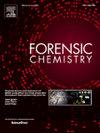使用优化的 1H selTOCSY 对火灾残骸中的汽油样本进行识别和个性化处理
IF 2.6
3区 医学
Q2 CHEMISTRY, ANALYTICAL
引用次数: 0
摘要
在火灾调查中检测和识别可燃液体是法医调查人员一直面临的挑战。本研究利用核磁共振分析的分析能力,对汽油复杂混合物中的痕量烯烃化合物进行鉴定,从而帮助确定汽油来源。事实证明,1H selTOCSY NMR 方法在研究以下四组烯烃方面取得了成功:在汽油样品中,3-甲基-1-丁烯(第 1 组)、3-甲基-1-丁烯和 1-戊烯的混合物(第 2 组)、2-甲基-2-丁烯(第 3 组)以及顺式和反式-2-戊烯的混合物(第 4 组)的蒸发程度不同,模拟了实际案例样品的风化作用,在蒸发 25% 和 50% 的情况下,仍能显著区分汽油品牌。事实证明,还可以对燃烧过的样品进行区分,包括燃烧过的汽油本身和在不同基质上燃烧过的汽油,这些基质包括木材、地毯、织物和代表常见家庭火灾残留物的纸质材料。对这些烯信号进行的 1H selTOCSY NMR 实验消除了光谱中大部分与烯无关的信号,从而使严重燃烧和污染的样品更加清晰,提高了使用四个烯标记对样品进行鉴别的能力。本文章由计算机程序翻译,如有差异,请以英文原文为准。
Use of optimized 1H selTOCSY for identification and individualization of petrol samples from fire debris
Detection and identification of ignitable liquids in fire investigation is ongoing challenge for forensics investigators. This study uses the analytical power of NMR analysis and permits the identification of trace amounts of olefinic compounds the complex mixture of petrol that aids the individualization of petrol sources. The 1H selTOCSY NMR method has proven to be successful in the investigation of the four sets of alkenes namely: 3-methyl-1-butene (set 1), a mixture of 3-methyl-1-butene and 1-pentene (set 2), 2-methyl-2-butene (set 3) and a mixture of cis and trans-2-pentene (set 4) in petrol samples evaporated to different extents, simulating the action of weathering of actual casework samples, and still achieved significant discrimination of petrol brands at 25 % and 50 % evaporation. Discrimination of burned samples also proved possible, both of burnt petrol its own and then petrol burned on different substrates including wood, carpet, fabric, and paper materials representing common household fire debris residues. 1H selTOCSY NMR experiments on these alkene signals remove most of the non-alkene-related signals from the spectra and thus provide additional clarity in heavily burnt and contaminated samples, increasing the capacity to discriminate between samples using the four alkene markers.
求助全文
通过发布文献求助,成功后即可免费获取论文全文。
去求助
来源期刊

Forensic Chemistry
CHEMISTRY, ANALYTICAL-
CiteScore
5.70
自引率
14.80%
发文量
65
审稿时长
46 days
期刊介绍:
Forensic Chemistry publishes high quality manuscripts focusing on the theory, research and application of any chemical science to forensic analysis. The scope of the journal includes fundamental advancements that result in a better understanding of the evidentiary significance derived from the physical and chemical analysis of materials. The scope of Forensic Chemistry will also include the application and or development of any molecular and atomic spectrochemical technique, electrochemical techniques, sensors, surface characterization techniques, mass spectrometry, nuclear magnetic resonance, chemometrics and statistics, and separation sciences (e.g. chromatography) that provide insight into the forensic analysis of materials. Evidential topics of interest to the journal include, but are not limited to, fingerprint analysis, drug analysis, ignitable liquid residue analysis, explosives detection and analysis, the characterization and comparison of trace evidence (glass, fibers, paints and polymers, tapes, soils and other materials), ink and paper analysis, gunshot residue analysis, synthetic pathways for drugs, toxicology and the analysis and chemistry associated with the components of fingermarks. The journal is particularly interested in receiving manuscripts that report advances in the forensic interpretation of chemical evidence. Technology Readiness Level: When submitting an article to Forensic Chemistry, all authors will be asked to self-assign a Technology Readiness Level (TRL) to their article. The purpose of the TRL system is to help readers understand the level of maturity of an idea or method, to help track the evolution of readiness of a given technique or method, and to help filter published articles by the expected ease of implementation in an operation setting within a crime lab.
 求助内容:
求助内容: 应助结果提醒方式:
应助结果提醒方式:


